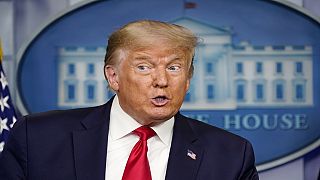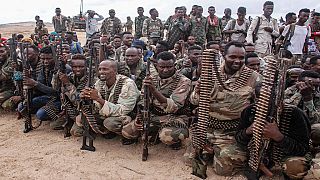Migrants
A cemetery for migrants who drowned while acrossing the Mediterranean in search of a better life in Europe is nearly half full in southern Tunisia — even before it is officially inaugurated.
Many of them drowned after boarding flimsy and overloaded boats while facing extortion from "gangsters and terrorists
Vicky, a Nigerian woman who was rescued from a shipwreck, says is grieved looking at the graves.
"It's a lots of lives that they lost here. And a lot of people who wanted to go to Europe and could not make it. Many people who have families, now they are looking for them, not knowing they are dead, so seeing these graves makes me feel very sad."
Tunisia and neighbouring Libya are key departure points for migrants, many from sub-Saharan African, who attempt the dangerous crossing from the North African coast to Europe, particularly Italy.
"A majority of the youth left by sea to Europe, so we had losses of dead Zarzisians. These migrants remind us of our children." added Mekki Lourraiedh, Mayor of Zarzis.
The locals hope that after the inauguration of the last cemetery, UNESCO and other the international movements would be off help in terms of finanincing more cemetries.
Many of those buried there remain nameless for now, and the headstones bear grim and scant information about them.
DNA analyses are been carried out on some of the bodies, with the hope that their families might find them someday.
- Honouring the nameless -
The cemetery is to be formally inaugurated on Wednesday by Audrey Azoulay, head of the UN's cultural agency UNESCO.
Many of those buried there remain nameless for now, and the headstones bear grim and scant information about them.
One is inscribed with the words: "Woman, black dress, Hachani beach", indicating the location where she was found.
Another reads: "Man, black sweater, Four Seasons Hotel beach".
"When I see this, I am not certain anymore that I want to make the sea crossing again," Vicky said.
Tunisia and neighbouring Libya are key departure points for migrants, many from sub-Saharan African, who attempt the dangerous crossing from the North African coast to Europe, particularly Italy.
In early May, the UN's refugee agency UNHCR said that at least 500 people had died trying to cross the Central Mediterranean this year, more than triple the 150 in the same period of 2020.
Koraichi, whose brother was swept away by a current while swimming for leisure in the Mediterranean, funded the cemetery by selling some of his artwork.
His brother's body was never found.
"I wanted to help the families get closure and for them to know that there is a place for a dignified burial" of their loved ones, he said.
"It is also a symbolic place, like the Tomb of the Unknown Soldier," he said, referring to monuments to fallen servicemen that can be found across the world.
A wooden door dating back to the seventeenth century leads into the cemetery where hand-painted ceramics line the ground and fragrant flowers, including jasmin, fill the air with a sweet scent.
A white cupola sits atop a chapel where worshippers from all faiths can pray.
Space has been allocated for a morgue and forensics lab to help identify the dead.
So far only one family from war-torn Libya has visited the cemetery to pray at the graveside of a young relative who had been identified by travel companions.
"We offered to let them take his body home but his father replied 'God has abandoned Libya, keep him here," Koraichi said.
- Weekly deaths -
Koraichi is a member of the Tijaniyyah order of Sufism, a spiritual form of Islam, which originated in North Africa before spreading to other parts of the continent.
He chose Zarzis as the place to build the Garden of Africa after learning that authorities in the fishing port were struggling to bury dozens of bodies of migrants that had washed up on its shores.
Municipal workers had buried more than 600 unidentified migrants -- from sub-Saharan Africa, Asia and elsewhere -- in a sandy, windswept plot near an old city dump.
That burial ground was already full when, in July 2019, another 100 bodies arrived, overwhelming the municipality.
That was when the first graves were dug at the Garden of Africa, even before the work to build the ornate cemetery had started.
Since then -- and especially in summer when the number of sea crossings rise -- bodies that washed up on the shores of Zarzis and around the region are brought in for burial each week.
Around 200 white bricks mark each empty grave in the cemetery.
Koraichi fears that they will fill up by the end of the summer.
Zarzis mayor Mekki Lourraiedh said the town itself had emptied over the years, as many young people left by sea seeking jobs and a better life in Europe.












01:05
Migrant centre in landmark New York hotel closes down
01:09
Former Tunisian president Moncef Marzouki sentenced to 22 years in absentia
01:32
Land convoy leaves Tunisia for Gaza, in an effort to break Israel's siege
01:06
Congo, Chad, Eritrea, Sudan and Somalia hit by U.S. travel ban
01:53
Italian Constitutional Court holds hearing on detention of rescue ship in 2024
01:03
Final destination for deportees flown out of the United States remains unknown